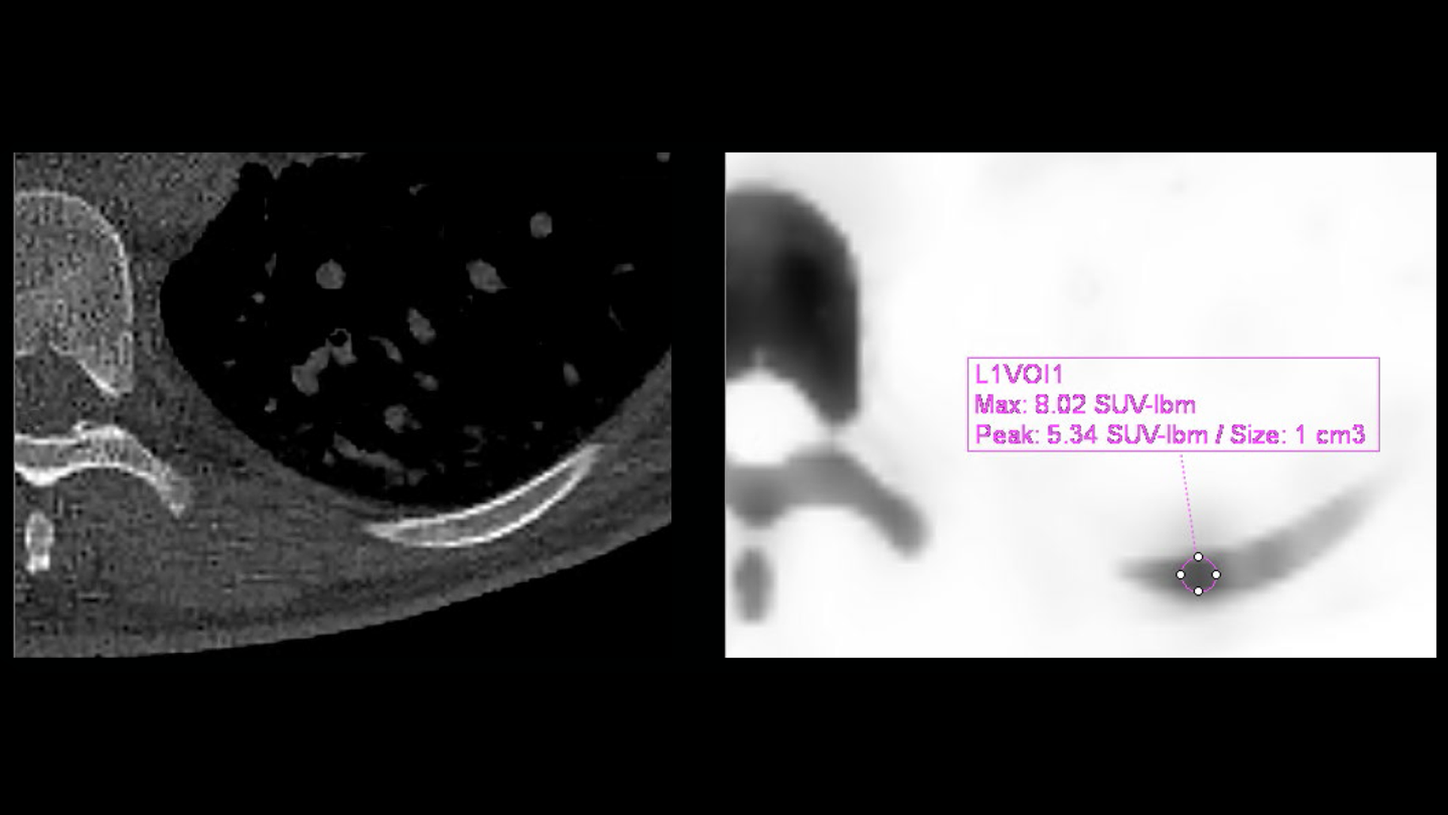History
An 84-year-old male with a more than 60 year history of tobacco use, previously diagnosed with squamous cell carcinoma of the oral cavity; specifically involving the right floor of mouth, buccal mucosa, and right mandible. He is 5 months status post-surgical resection, right cervical neck dissection, and adjuvant radiation therapy. A PET/CT was ordered for subsequent treatment strategy (STS) to assess residual disease of the oral cavity and performed on a Biograph mCT Flow™ PET/CT system.1
Findings
The patient was scanned on a Biograph mCT Flow 64 scanner approximately 1 hour following the intravenous administration of 10.5 mCi (388 MBq) Fludeoxyglucose F 18 injection (18F FDG). A single whole-body scan with the FlowMotion™ technique was utilized and a diagnostic contrast-enhanced CT was performed in conjunction. The head and neck area was acquired at 0.4 mm/s with a 400 x 400 matrix and the remainder of the body to the thighs was acquired using a faster acquisition at 1.0 mm/s with a 200 x 200 matrix. The findings are compatible with disease progression with new hypermetabolic activity involving the right floor of the mouth. There is also new hypermetabolic bilateral cervical neck adenopathy, namely bilateral level II, III, and right medial sub-pectoral lymph nodes. There is intense hypermetabolic focus in the floor of the anterior part of the mouth that is a concern for local regional disease progression versus abscess formation. Significant beam hardening artifact is noted secondary to dental hardware.
Comments
Squamous cell carcinoma (SCC) is the most common malignant tumor of the head and neck, which is often diagnosed late with poor prognosis and is particularly prevalent in males with a significant history of tobacco use and alcohol consumption. Many cases of oral cancer are treated with surgery, which may require rebuilding parts of the oral cavity to preserve the appearance and function of the mouth. Radiation therapy may also be utilized as treatment along with surgery. Chemotherapy may also be used before or after surgery, or used alone when the cancer is diagnosed in a later stage. Moreover, effective chemotherapy can control further spread of the cancer. There are several challenges unique to head and neck cancer imaging, such as complex anatomy, need for accurate T and N staging and especially post-therapy changes, which significantly alter head and neck anatomy and physiology.
The utility of PET/CT-directed management of the post-treatment neck after definitive radiation therapy and chemoradiation is of paramount importance in the follow-up period. PET/CT is the diagnostic modality of choice in identifying residual disease and recurrence, and differentiating disease from post-radiation changes.5 It has been shown that PET/CT has a negative5 predictive value (NPV) of 75% compared to 37.5% for CT alone.1 According to clinical guidelines, a negative PET/CT scan is 90% reliable and further imaging is optional on patients who have a clinically negative neck.
Various types of head and neck image acquisition protocols are implemented to physician preference. Options include a single PET/CT acquisition from the vertex to thighs with the patients’ arms down. As well as the two-step acquisition, which includes a dedicated head and neck PET/CT exam with the patients’ arms down and an optimized field-of-view (FoV) diagnostic CT, followed by a chest, abdomen, and pelvis PET/CT scan with the patients’ arms up. No matter the choice in acquisition protocol, FlowMotion technology allows for regional customized acquisition parameters. As such, a slower acquisition from the vertex to top of sternum with a 400 x 400 matrix can be performed for optimal imaging of the head and neck, while a faster acquisition with a 200 x 200 matrix can be performed through the rest of the body for a faster exam (Figure 1). Post-reconstruction of the head and neck CT can be performed with thinner slices for optimal anatomical visualization.
In addition to FlowMotion Technology, iterative metal artifact reduction (iMAR) addresses issues with beam hardening from artificial joints, pacemakers, and, in this case example, dental implants without increasing radiation dose. The application of iMAR results in images with a reduced level of metal artifacts compared to conventional reconstruction if the underlying CT data is distorted by metal being present in the scanned object. Twenty-one percent of CT scans present metal artifacts that can obscure vital information.3 When significant, beam hardening has the ability to corrupt image quality, this can result in the obscuring of important clinical findings and can potentially lead to inaccurate staging of disease. On the Biograph family of PET/CTs, iMAR images can be utilized in the PET reconstruction and provide improved information for the attenuation correction. A publication from the Journal of Nuclear Medicine (JNM) evaluated iMAR algorithm concluding, “The added diagnostic value depends on the location and size of the prosthesis/metal implant, in combination with the indication for the PET/CT scan, and location and extent of the disease. It can influence lesion detection in case of staging and detection of disease, and quantification of the lesion in case of radiotherapy planning and therapy response monitoring.”4 Thus the iMAR algorithm reduces” metal artifacts revealing more visibility of patient anatomy, increasing physician confidence in interpretation of the PET/CT exam (Figure 2).
Conclusion
Since the anatomy in the post-therapy neck is significantly altered, anatomical modalities are often equivocal in the evaluation of head and neck cancers. 18F FDG PET/CT has become widely accepted as the modality of choice when evaluating residual disease or disease recurrence in the post-therapy setting in head and neck cancers and has shown to be cost-effective in post non-surgical therapy surveillance.5
Siemens Healthineers has further optimized PET/CT head and neck oncology imaging with new technological advances. FlowMotion allows for customizable imaging of body territories, providing for even further enhanced imaging of an anatomical region of interest. This is particularly useful in head and neck cancers where the complexity of compact anatomical space is following surgery or radiation therapy. iMAR allows for the correction of beam hardening artifacts from dental and cervical neck hardware, potentially allowing detection of disease that would otherwise have been obscured.











